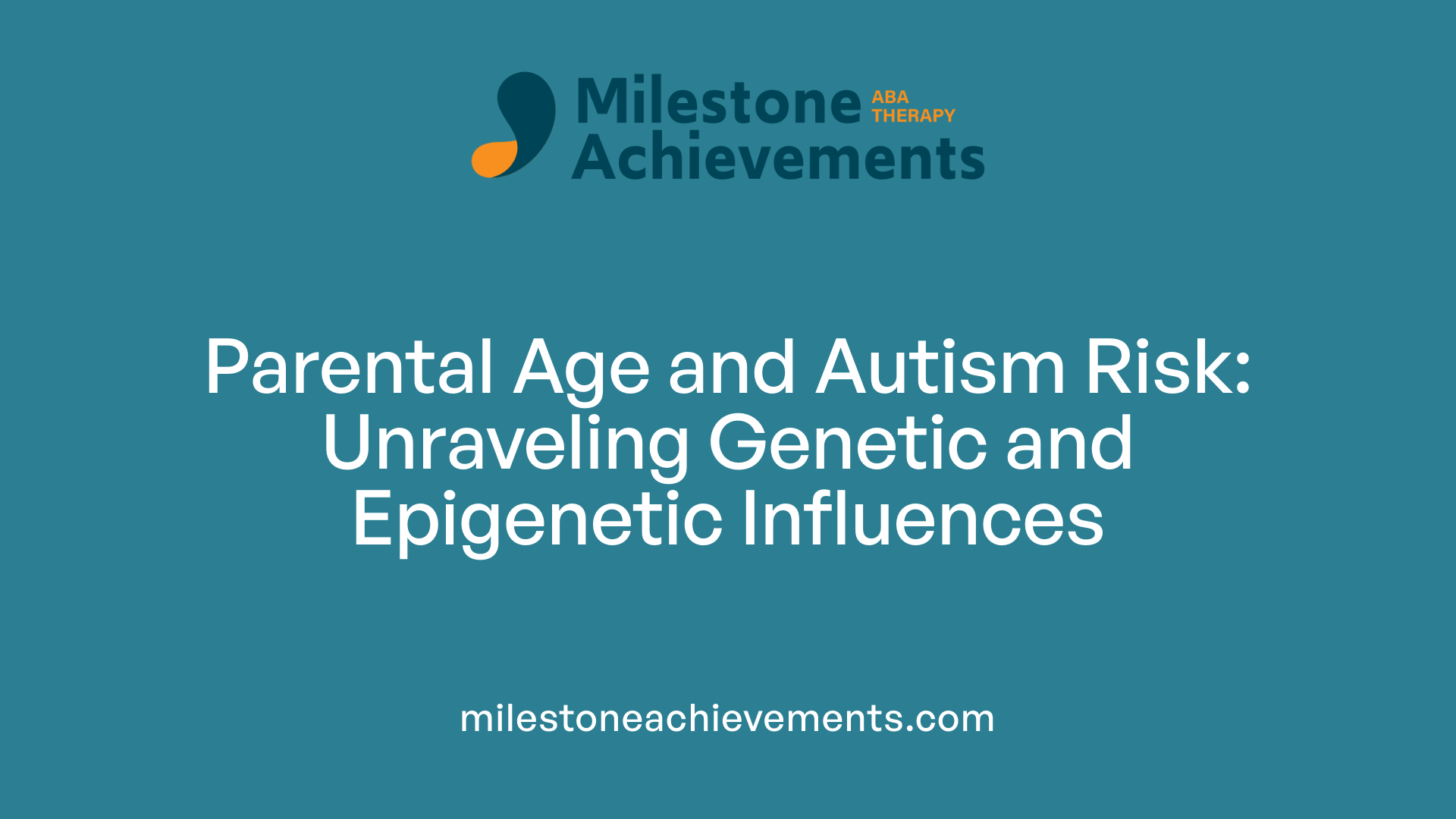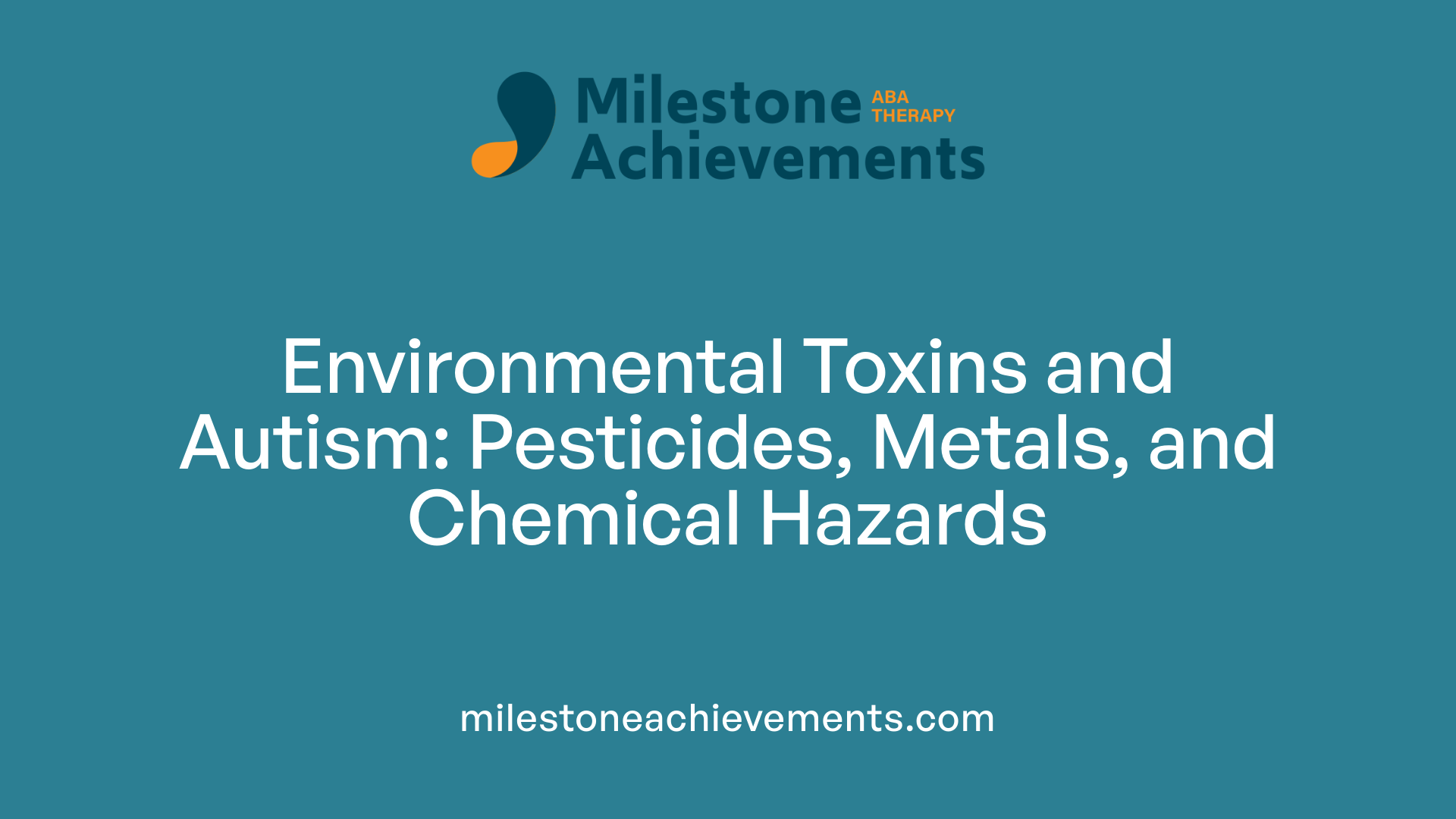
Environmental Influences on Autism Development
Environmental and Genetic Factors Shaping Autism Spectrum Disorder
Understanding the multifaceted roots of autism
Autism Spectrum Disorder (ASD) is a complex neurodevelopmental condition influenced by an interplay of genetic and environmental factors. While genetics play a predominant role in determining autism risk, environmental exposures—particularly those occurring during critical periods of prenatal and early postnatal development—also contribute significantly. This article explores the various physical, chemical, and biological environmental influences on autism development, illustrating how they interact with genetic predispositions to shape neurodevelopmental outcomes.
Genetic and Parental Age Factors in Autism

How does the age of parents influence autism risk?
Older parental age, especially the father's age, is linked to a higher likelihood of autism in children. Research shows that fathers aged 34 and above have an increased risk, and this risk escalates as age increases. Mothers over 34 also contribute to this elevated risk, although paternal age tends to have a stronger association.
Each additional 10 years of parental age can increase the chance of autism by approximately 18% for mothers and 21% for fathers. This link is partly due to the accumulation of genetic mutations in sperm and eggs over time. As parents age, especially fathers, the number of de novo mutations—new genetic changes not inherited from previous generations—in sperm DNA increases. These mutations can affect crucial genes involved in brain development, raising the potential for autism.
What are de novo mutations and how do they contribute?
De novo mutations are genetic alterations that occur spontaneously in sperm or egg cells and are passed to the child at conception. These mutations are not present in the parents' somatic cells and can significantly influence neurodevelopment.
Increased paternal age correlates with a higher number of these mutations because sperm cells continually divide throughout a man's life, accumulating errors. These mutations can interfere with normal brain development and are linked to autism risk.
How do epigenetic changes tie into parental age?
Beyond genetic mutations, epigenetic modifications—chemical changes that affect gene activity without altering the DNA sequence—also play a role. Advanced parental age can lead to epigenetic alterations in sperm and eggs, which may influence how genes are expressed during fetal development.
Such modifications can disrupt normal neurodevelopmental processes, further increasing autism susceptibility. Consequently, both de novo genetic mutations and epigenetic impacts stemming from parental age contribute to the risk of autism in offspring.
Understanding these mechanisms emphasizes the importance of considering parental age in parental planning and highlights the complex interaction between genetics, environment, and development in autism risk.
Maternal Health and Its Impact on Autism Risk

How do maternal physical health issues during pregnancy influence autism risk?
Maternal health problems like metabolic syndrome, infections—whether viral or bacterial—and bleeding during pregnancy are associated with a higher chance of autism in children. These issues can impact fetal brain development through mechanisms such as hypoxia, which is a lack of oxygen, and immune activation. For example, if a mother experiences severe infections, her immune response can create an environment that affects neural development.
Pregnancy complications such as bleeding or metabolic disturbances also elevate the risk. These factors can cause stress and inflammation, potentially altering critical processes in fetal growth. Additionally, maternal conditions like pre-eclampsia, diabetes, or obesity are linked to increased autism susceptibility, likely by affecting nutrient supply and supporting abnormal fetal development.
Understanding these health issues emphasizes the importance of regular maternal care and management of health conditions during pregnancy to help reduce potential risks.
What is the effect of maternal mental health problems such as depression, anxiety, and stress?
Maternal mental health can significantly influence fetal development through various biological pathways. Conditions like depression, anxiety, and chronic stress during pregnancy may lead to changes in the fetal environment via epigenetic mechanisms—alterations in gene expression without changing DNA sequences.
Stress hormones such as cortisol can cross the placenta, potentially affecting brain development. Epigenetic modifications resulting from maternal mental health issues might impact neural connectivity and function, increasing the likelihood of autism spectrum disorder.
Addressing mental health concerns during pregnancy through support and treatment not only benefits maternal well-being but may also decrease the risk factors associated with autism in offspring.
Are autism risk factors inherited, environmental, or both?
Autism risk factors encompass both genetic and environmental components. Family and twin studies reveal that genetic mutations, including spontaneous de novo mutations linked to parental age, play a crucial role in prevalence. These genetic factors involve hundreds of genes related to brain development, supporting a strong inherited component.
However, environmental influences during prenatal development—such as exposure to pollutants, maternal health challenges, and medication use—also contribute to autism risk. The interaction between genetic predispositions and environmental exposures makes autism a complex disorder, with no single cause. Instead, it results from a dynamic interplay that varies among individuals.
Research continues to explore how these elements combine, underscoring the importance of both genetic counseling and environmental health measures to understand and potentially mitigate autism risk.
Environmental Toxins and Chemical Exposures

What developmental and environmental factors are associated with autism?
Autism spectrum disorder (ASD) is a neurodevelopmental condition characterized by challenges in social interaction, communication, and repetitive behaviors. While genetics play a significant role, environmental exposures during early development are also influential.
Developmental factors linked to autism include genetic mutations, chromosomal abnormalities, and birth complications such as oxygen deprivation or prematurity. These factors affect brain development directly. Besides genetics, environmental influences during pregnancy and early childhood are increasingly being studied for their impact.
Exposure to pollutants like pesticides, heavy metals, and chemicals in water and air has been associated with higher risks of ASD. These toxicants may interfere with normal brain development through various mechanisms, including inducing oxidative stress, inflammation, and epigenetic modifications.
Research indicates that factors like maternal health issues—such as metabolic syndrome, infections, and mental health problems—along with parental age, especially paternal age over 34, contribute to autism risk.
Multiple environmental toxins can cause DNA damage or epigenetic alterations, which may disrupt crucial neurodevelopmental processes. This complex interaction of genetic susceptibility and environmental exposure underscores the multifaceted origins of autism.
Impact of pollutants such as pesticides, heavy metals, and air and water contaminants on neurodevelopment
Environmental pollutants are increasingly linked to ASD. Pesticides like chlorpyrifos and glyphosate have been associated with neurodevelopmental disturbances. Heavy metals such as inorganic mercury and lead can lead to genomic instability and neurotoxicity.
Air pollution, including particulate matter from diesel exhaust and traffic emissions, has been associated with increased autism risk. Children exposed prenatally and postnatally show higher susceptibility to neurodevelopmental disorders.
Water contaminants, including toxic chemicals from industrial waste and agricultural runoff, also pose risks. These substances can penetrate fetal and early childhood development, disrupting critical brain processes.
Mechanisms including epigenetic changes, oxidative stress, and inflammation
The ways these environmental exposures influence autism include multiple biological pathways:
| Mechanism | Description | Impact on Neurodevelopment |
|---|---|---|
| Epigenetic changes | Chemical exposures can alter DNA methylation and histone modification, affecting gene expression without changing the DNA sequence | Disrupted gene regulation during brain development, increasing ASD susceptibility |
| Oxidative stress | Toxicants generate reactive oxygen species (ROS), damaging DNA, proteins, and lipids | Impairs neuron formation and connectivity, potentially contributing to ASD |
| Inflammation | Pollutants trigger immune responses and systemic inflammation | Fetal immune activation can interfere with normal brain wiring |
These mechanisms collectively contribute to the increased risk of ASD following environmental toxin exposure. While research continues, understanding these pathways helps clarify how external factors impact neurodevelopment and can inform preventive strategies.
Birth Complications and Postnatal Factors

What are effects of low birth weight, jaundice, and infections on brain development?
Low birth weight, jaundice, and infections during the early stages of life have been associated with increased risk of autism. Low birth weight often indicates premature birth or growth restrictions, which can affect the brain's development due to less optimal conditions for neural growth. Jaundice, characterized by high levels of bilirubin, if severe or untreated, can lead to neurological damage such as kernicterus, impacting brain function.
Infections, whether viral or bacterial, can activate the immune system and lead to immune responses that may interfere with fetal brain development. Such immune activation can result in neuroinflammation, which has been linked to the development of ASD. These factors can contribute to the disruption of normal neural circuitry formation, which is crucial during early childhood.
What is the impact of birth trauma, oxygen deprivation, and prematurity?
Birth trauma, including physical injury sustained during delivery, can cause direct damage to the brain tissues. Oxygen deprivation, or perinatal hypoxia, deprives the brain of essential oxygen, leading to injury in vulnerable regions responsible for social and communication skills.
Premature or very early births are particularly risky because they often involve underdeveloped organs and brain structures. Prematurity is associated with a higher likelihood of complications such as bleeding in the brain (intraventricular hemorrhage) and impaired neural connectivity, both of which may contribute to autism spectrum disorder.
These postnatal factors affect neurodevelopment by inducing hypoxia, trauma-induced inflammation, and structural brain changes. Recognizing these risks underscores the importance of careful monitoring and intervention during and after birth to support optimal developmental outcomes.
Environmental Pollutants and Neurodevelopment
 Exposure to various environmental pollutants has been increasingly associated with a higher risk of autism spectrum disorder (ASD). Key pollutants include air pollution, pesticides, and chemicals such as phthalates and flame retardants.
Exposure to various environmental pollutants has been increasingly associated with a higher risk of autism spectrum disorder (ASD). Key pollutants include air pollution, pesticides, and chemicals such as phthalates and flame retardants.
Air pollution, especially particulate matter and nitrogen dioxide, has been linked to neurodevelopmental issues. Studies show that children exposed to higher levels of these airborne toxins before and after birth are more susceptible to ASD. These pollutants can cause oxidative stress and inflammation in the brain, disrupting normal development.
Pesticides like chlorpyrifos and glyphosate are widely used in agriculture and have been implicated in autism. These chemicals can interfere with neural signaling and induce genetic mutations, especially when exposure occurs during fetal development.
Chemicals like phthalates, commonly found in plastics, and flame retardants, used in furniture and electronics, are also of concern. They are endocrine disruptors that may alter hormonal pathways critical for brain development.
Environmental toxins may cause epigenetic changes — alterations in gene expression without changing the underlying DNA sequence — impacting neural development. They can also induce genetic mutations via oxidative stress and direct DNA damage.
Studies highlight the importance of minimizing exposure, especially during pregnancy, to reduce potential neurodevelopmental risks. Avoiding areas with high air pollution, limiting contact with pesticides, and reducing use of plastics containing harmful chemicals are practical steps.
Research continues to explore how these chemicals interact with genetic susceptibilities, contributing to increased ASD prevalence. Understanding these linkages is vital for developing effective prevention strategies.
Combining Genetic and Environmental Perspectives
How do genetic susceptibility and environmental exposures interact in autism risk?
Autism spectrum disorder (ASD) results from a complex interplay between genetic factors and environmental influences. Genetic predisposition plays a significant role, with certain gene mutations and familial history increasing vulnerability. However, environmental exposures can modify this risk, especially during critical periods such as prenatal development. For example, genetic susceptibility may make some individuals more sensitive to environmental toxins like air pollutants or pesticides, leading to higher chances of developmental disruption.
What is the role of de novo mutations and environmental pollutants?
De novo mutations are new genetic alterations occurring in germ cells or early embryonic development. Advanced parental age, particularly paternal over 34 years, correlates with an increased rate of these spontaneous mutations. Environmental pollutants—including heavy metals like mercury and lead, pesticides, and chemicals such as phthalates—can also induce mutations or damage DNA through direct interaction or oxidative stress. These mutations and DNA damages can disturb normal neurodevelopment, elevating ASD risk.
How do mechanisms like oxidative stress, inflammation, and signaling disruption contribute?
Environmental toxicants often cause oxidative stress by generating reactive oxygen species (ROS), which damage DNA, lipids, and proteins. This damage can lead to mutations, genomic instability, and interference with gene expression. Additionally, some chemicals trigger immune activation, resulting in inflammation that impacts fetal brain development. Disruption of signaling pathways, such as neurotransmitter systems or endocrine functions, further impairs neuronal growth and synapse formation. Collectively, these mechanisms link environmental exposures to the biological alterations underlying ASD.
Current Scientific Understanding and Future Directions
How do environmental and genetic factors contribute to autism?
Research indicates that both genetic and environmental influences are integral to understanding autism spectrum disorder (ASD). Genetic factors play a significant role, with evidence from twin studies showing that while identical twins often share ASD, discordance suggests environmental influences are also impactful.
Environmental exposures, especially during critical periods of fetal development, can increase ASD risk. Factors such as advanced parental age, maternal health issues like diabetes and obesity, prenatal infections, and birth complications like hypoxia or prematurity have been linked to higher susceptibility.
Various toxins and chemicals—pesticides, heavy metals, air pollutants, fragrances, phthalates, and solvents—may induce epigenetic changes and cause DNA damage, contributing to neurodevelopmental alterations.
Degenerative mechanisms, including oxidative stress and inflammation, are also involved. For example, toxicants can generate reactive oxygen species (ROS), leading to DNA damage and increased mutation rates. These mutations can occur de novo, often inherited from parental germline cells affected by environmental toxicants.
Overall, up to 50% of ASD risk may be attributable to environmental factors, especially when combined with genetic vulnerabilities. This complex interaction influences neurodevelopment and may trigger epigenetic modifications that predispose to ASD.
What are potential interventions and policies to reduce exposure to environmental risk factors?
To mitigate risks, policies aimed at reducing exposure to harmful chemicals are vital. This includes stricter regulation of pesticides, industrial pollutants, and hazardous chemicals like phthalates and flame retardants. Promoting cleaner, pesticide-free farming and increased monitoring of environmental toxins near residential areas can help.
Public health initiatives should focus on educating pregnant women and families about avoiding pollutant exposure—such as avoiding living near farms with pesticide use or contaminated water sources. Ensuring proper nutrition, including folic acid and omega fatty acids, supports healthy fetal brain development.
Healthcare providers can offer guidance on medication use during pregnancy, cautioning against drugs like valproic acid, which have known links to increased autism risk. Screening for maternal health issues and managing conditions such as diabetes and obesity are also essential.
In the clinical setting, early detection programs and interventions can support children at risk, addressing sensory sensitivities and enhancing social communication. Continued research into environmental toxins and their biological impact guides policy development.
Why is ongoing research important?
Unraveling the complex interactions between genes and environment is crucial for developing effective prevention and treatment strategies. Future research aims to identify specific toxicants, genetic susceptibilities, and epigenetic markers that predict autism risk.
In particular, understanding how environmental exposures induce genomic instability and affect DNA repair processes can lead to targeted interventions. Investigating the timing, dose, and combined effects of exposures will further refine risk assessments.
Innovative approaches, including high-throughput screening of chemicals and advanced genetic analysis, will deepen insights into ASD etiology. Ultimately, continued research supports the development of policies and programs to create safer environments and promote neurodevelopmental health for future generations.
Harmonizing Genetic and Environmental Insights for Autism Prevention and Support
The development of autism spectrum disorder is multifactorial, involving an intricate interplay between genetic predispositions and environmental exposures. Recognizing the influence of parental age, maternal health, environmental toxins, and birth complications provides a broader understanding of potential risk factors. Advances in research continue to reveal how chemical pollutants, air contaminants, and toxic agents can induce genetic mutations, oxidative stress, and epigenetic modifications, ultimately affecting neurodevelopment. These insights emphasize the importance of reducing exposure to hazardous environmental agents through public health initiatives, regulatory policies, and personalized preventive strategies. Despite the complexity, integrating genetic and environmental knowledge offers promising pathways for early intervention, tailored support, and fostering autism-friendly environments, ultimately improving outcomes and quality of life for individuals with ASD.
References
- Environmental factors influencing the risk of autism - PMC
- What Role Does the Environment Play in Autism?
- Environmental factors in autism: Research and support
- Autism Environmental Factors
- Environmental risk factors for autism: an evidence-based review of ...
- Environmental factors in the development of autism spectrum ...
- Environmental exposures associated with elevated risk for autism ...
- Which Parent Carries Autism? Understanding the Genetic Links


Partner with us on your child's journey
Milestone Achievements offers evidence-based ABA therapy to help children with autism reach their full potential. Together we’ll set meaningful goals and celebrate progress every step of the way.
Start ABA Services Today


